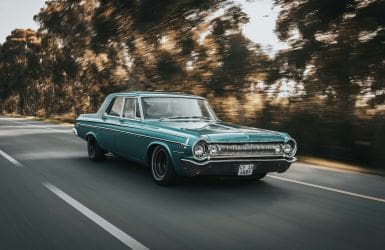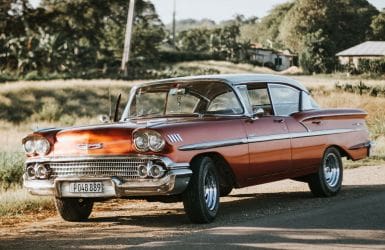Cost increase in vintage car ownership 1200%?
-Council of State gives politics a fat fail
On Budget Day 2013, there came clarity regarding the 2014 tax plan. This does not make the average oldtimer enthusiast happy. This is because the oldtimer regulation proposed earlier this year will be included in the tax plan in unchanged form. If the Lower and Upper Houses approve this proposal, many old-timer owners will be forced to part with our cultural driving heritage.
The proposals for vintage cars in brief
The "40-year compromise" has been adopted in unchanged form in the 2014 tax plan.
From 2014, owners of vintage cars aged 40 years or older will remain exempt from road tax. However, owners of old-timers aged 26 to 40 years will have it pretty tough;
- If the vintage car is 26 to 40 years old on January 1, 2014, and runs on diesel or LPG, then because of the environmental aspect- one must pay the full road tax.
- If the oldtimer is 26 to 40 years old on January 1, 2014 and runs on gasoline, then one is eligible for a transitional arrangement. This means that "only" a quarter rate (25% of the annual road tax) per year, with a maximum of 120 euros, must be paid. However, this arrangement can only be used if the oldtimer is not on the public roads during a quarter (December, January and February). The oldtimer may not be driven on public roads during this period, but the oldtimer may also not be parked on public roads and must be parked. If this does not happen, the old-timer owner is still obliged to pay the full road tax rate, as well as a default fine of up to 4920 euros.
And because the quarter rate is already such a "favorable" regulation, in the case of import, export, interim sale or scrapping, no refund of the excess tax paid will be granted.
Every last quarter of the year, the tax authorities will approach the holder of an eligible vintage car asking if they wish to take advantage of the scheme.
Fuel taxes
On Budget Day it was also announced without any hesitation, that excise taxes on fuel are also going up sharply. Apart from the annual inflation correction, excise duty on diesel will rise by 3 cents per liter and excise duty on LPG will increase by 7 cents per liter. Riders on "green" gas will receive a small excise tax rebate for a few years. No mention is made of the fact that the price of a liter of gasoline has already risen by a whopping 54% between 2002 and 2012.

Cost increase for vintage car owners skyrockets
According to VWE (Vehicle Information and Documentation), nearly 70% of Dutch vintage cars will be affected by the announced tax measures.
Below is a calculation example comparing the current and new tax regime. Since 1 in 4 vintage cars is a Mercedes-Benz, we have also taken a Mercedes in our calculation example
Motor vehicle tax (MRB).
-Mercedes-Benz 200 (B/D/LPG)
-Passenger car
-Weight 1151 to 1250 kg
-Province of Utrecht
| MRB 2014 | MRB old scheme | Increase | ||
| BENZINE | ||||
| Oldtimer 25 years | No transitional arrangement* | € 556,00 | € 0,00 | € 556,00 |
| Oldtimer 25 years | Transitional | € 120,00 | € 0,00 | € 120,00 |
| Oldtimer 35 years | No transitional arrangement | € 556,00 | € 0,00 | € 556,00 |
| Oldtimer 35 years | Transitional | € 120,00 | € 0,00 | € 120,00 |
| Oldtimer 40 years | Unchanged/exempt | € 0,00 | € 0,00 | € 0,00 |
| MRB 2014 | MRB old scheme | Increase | ||
| DIESEL | ||||
| Oldtimer 25 years | Full rate | € 1160,00 | € 0,00 | € 1160,00 |
| Oldtimer 35 years | Full rate | € 1160,00 | € 0,00 | € 1160,00 |
| Oldtimer 40 years | Unchanged/Exempt | € 0,00 | € 0,00 | € 0,00 |
| MRB 2014 | MRB old scheme | Increase | ||
| LPG | ||||
| Oldtimer 25 years | Full rate | € 1232,00 | € 0,00 | € 1232,00 |
| Oldtimer 35 years | Full rate | € 1232,00 | € 0,00 | € 1232,00 |
| Oldtimer 40 years | Unchanged/Exempt | € 0,00 | € 0,00 | € 0,00 |
*Transition scheme: vintage cars that are between 26 and 40 years old and run on gasoline on January 1 are eligible for a quarter rate with a maximum of € 120.00. The condition is that they do not use public roads in December, January and February. The transitional regime does not apply to vehicles running on LPG and Diesel.
Council of State gives a fat insufficient
The Council of State considers the old-timer regulation as agreed upon this spring to be unclear, far too complicated and not enforceable. Therefore, the political body also believes that the regulation should be revised. The Council of State finds it hard to verify that gasoline-powered cars aged 26 to 40 years are not allowed to drive for a quarter under the transitional arrangement.
Also the environmental argument regarding old-timers on diesel and LPG is hardly controllable and therefore not feasible. The "40-year compromise" is also inconsistent and contradicts the earlier views of Secretary of State Frans Weekers; in a parliamentary debate he indicated that he had no intention of creating separate rules for specific groups of old-timer owners. However, this is at odds with the current old-timer regulations. The Council of State therefore thinks that the old-timer regulation should be changed.
Exemptionoldtimer.nl
The organization vrijstellingoldtimer.nl has previously successfully campaigned on behalf of oldtimer owners against unjust and unmotivated government policies. Again, the team of Vrijstelling Oldtimer does not accept the 40-year compromise. Legally, they consider the proposal not watertight. In addition, the regulation would not be evaluated until 2015 (the Van Vliet Amendment), so why this has already happened is a big mystery.
What does the Van Vliet Amendment entail
This provided for the following measures as of January 1, 2012:
- Exemption age raised from 25 to 30 years old
- Existing cases (built in 1986 and older) are 25 years or older on that date and remain fully exempt
- Transitional regulation for vehicles with a year of construction from 1987 to 1990.
The exemption age is gradually shifting from 26 years to 29 years for these construction years between 2012 and 2019.
- For vehicles built in 1987 or later, the exemption applies only to the basic amount and the provincial surcharge (specifically, fuel surcharge for LPG and diesel cars, not for gasoline cars)
- There will be a weighing in 2015 on the policy initiated by this amendment
ANWB has joined the fray
The ANWB has also entered the fray. The ANWB has added up all the burden increases and comes to the conclusion that the motorist will provide 1 billion extra in income next year. A not small amount that will largely come from the oldtimer driver who will be affected by the burden increases on several fronts.
BOVAG and RAI Association
That the government already earns more than enough from motorists is shown in the latest edition of Mobility in Figures Cars from the Bovag and Rai Association. The central government generates income from excise duty on fuels, insurance tax on car insurance, motor vehicle tax, traffic fines and VAT on fuel, repairs, maintenance and traffic training. Provinces receive surcharges in motor vehicle taxes.
Municipalities earn from parking fees. Adding up this revenue adds up to a total of nearly 20 billion earned from motorists. Converted about 2141 euros per vehicle per year. While spending by the State on traffic facilities last year was 5.2 billion euros, including work on the railroad.
Crushing blow to cultural driving heritage
Besides the announced disappearance of the exemption from motor vehicle taxes for oldtimers and the increase in fuel excise taxes, the oldtimer enthusiast already had to deal with more issues last year that reduced the enjoyment of the hobby. As of January 2013, the government increased the insurance tax from 9.7% to 21%, insurance companies drastically increased the oldtimer insurance premiums and the underwriting standards were tightened as a result of the sharply increased claim burden.
To find an insurer with a low oldtimer premium, the desired coverage and favorable policy conditions is becoming increasingly difficult. Not to mention the exclusions; for example, Europeesche no longer accepts oldtimers that are not parked in an enclosed garage, Avro refuses oldtimers on LPG or diesel and Nationale Nederlanden no longer insures oldtimers if there is not a first use car. Furthermore, certain car brands will be excluded from the oldtimer insurance, fewer kilometers per year may be driven with the oldtimer, oldtimers under the age of 25 will no longer be considered oldtimers, and there must be a brand club of the brand of the oldtimer.
You can read more about the changes and consequences for oldtimer enthusiasts here; Oldtimer owners severely duped.
Calculate your vintage car insurance premium right away!
We can be reached via chat, WhatsApp, phone or email
Questions? Contact us if you want to know more.
We are here Monday to Friday from 08:00 to 18:00.






